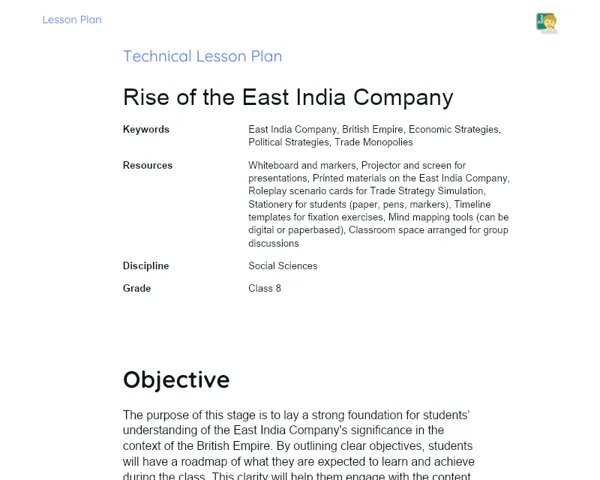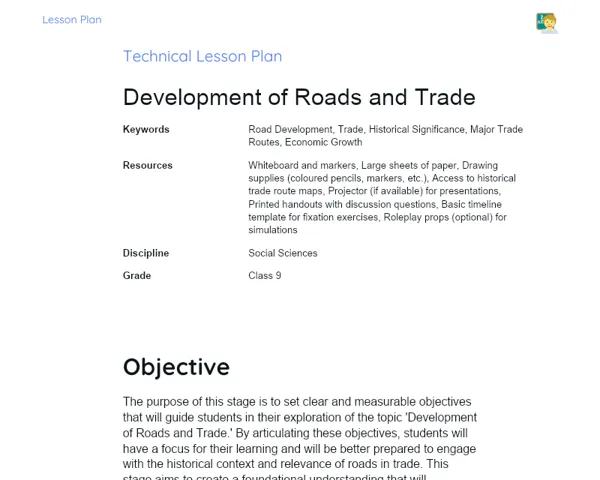Technical Lesson Plan | Advertising and Consumer Behavior
| Palavras Chave | Advertising, Consumer Behavior, Influence, Techniques, Decision-Making, Psychological Triggers, Interactive Learning, Group Activities, Critical Thinking, Real-World Applications, Marketing Skills |
| Materiais Necessários | Whiteboard and markers, Projector or smartboard, Paper and art supplies for poster creation, Digital devices for research (if available), Printed examples of various advertisements, Markers, glue, scissors for group activities, Access to online advertisement databases (if applicable), Timer for activity management, Reflection worksheets |
Objective
Duration: (10 - 15 minutes)
The purpose of this stage is to establish a foundational understanding of how advertising shapes consumer behavior. By identifying the main objectives, the teacher will align the lesson's content with the skills required for students to critically analyze advertisements and comprehend their wide-ranging impacts. This stage will engage students in interactive discussions, helping them relate the concepts to everyday experiences, thus fostering a deeper insight into the world of advertising and its relevance to their lives.
Main Objectives:
1. Understand the influence of advertising on consumer preferences and behaviors.
2. Identify different advertising techniques and their intended effects on consumers.
3. Analyze specific advertisements to evaluate their impact on consumer decision-making.
Side Objectives:
- Discuss the role of culture and society in shaping advertising strategies.
- Explore ethical considerations in advertising and how they affect consumer perceptions.
Introduction
Duration: (10 - 15 minutes)
The purpose of this stage is to establish a foundational understanding of how advertising shapes consumer behavior and to engage students actively by relating the topic to their daily experiences. By contextualizing advertising in their lives and the job market, the teacher aims to ignite curiosity and foster a sense of relevance, setting a motivating tone for the lesson ahead. This initial engagement will prepare students for deeper exploration into advertising techniques and the psychology behind them.
Curiosities and Market Connection
Did you know that the average person sees over 5,000 advertisements each day? That's nearly 200,000 ads a month! Understanding how these advertisements influence our choices and preferences is key, especially as many students aspire to enter the job market in marketing, advertising, or entrepreneurship. By grasping the nuances of consumer behaviour and advertising tactics, students can better prepare themselves for future roles that involve shaping and communicating brand messages.
Contextualization
In today's digital age, where everything from clothes to gadgets is just a click away, understanding advertising becomes crucial for students. Advertising is not just about flashy commercials or catchy jingles; it shapes our preferences and influences our decisions in ways we might not even realise. It plays a vital role in the marketplace by encouraging businesses to sell their products while also guiding consumers in their choices. Thus, learning about advertising can empower students to make informed decisions as they navigate the world around them, and can also prepare them for engaging careers in various fields such as marketing, media, and sales.
Initial Activity
Begin the class with an interactive brainstorming session. Write 'Advertisements' on the board and ask students to call out any advertisements they remember from the past week—be it from TV, social media, or billboards. As students share their examples, encourage them to describe what attracted them to these ads and whether those ads influenced any of their recent purchases. This will help students activate prior knowledge and relate personally to the topic of advertising and consumer behaviour.
Development
Duration: (40 - 50 minutes)
The purpose of this stage is to deepen students' understanding of the fundamental concepts of advertising and consumer behavior through an engaging mix of theory and practical activities. By discussing essential topics, encouraging reflection, and introducing a mini challenge, the teacher aims to foster critical thinking and creativity among students, making the learning experience interactive and relevant.
Topics
1. Definition of Advertising: Explain what advertising is and its key components, including the target audience, message, and medium.
2. Types of Advertising: Detail the various types of advertising such as print, digital, radio, and social media, and their unique characteristics.
3. Psychological Impact of Advertising: Discuss how advertisements use psychological triggers such as emotional appeal, fear, and humor to influence consumer behavior.
4. Consumer Decision-Making Process: Introduce the stages of the consumer decision-making process, including problem recognition, information search, evaluation of alternatives, purchase decision, and post-purchase behavior.
Thoughts on the Subject
Encourage students to think about their own experiences with advertisements. Ask them to reflect on a recent purchase – what led them to choose a specific product? Was it an advertisement they saw on social media, a brand they trust, or a recommendation from a friend? This reflection will help students connect theory to personal experience and understand the relevance of advertising in their lives.
Mini Challenge
Create Your Own Advertisement!
Students will work in small groups to create a simple advertisement for a product of their choice. They should incorporate different advertising techniques learned during the lesson and present their advertisement to the class.
1. Divide the class into small groups of 4-5 students each.
2. Each group chooses a product they would like to advertise.
3. Groups brainstorm and come up with a unique selling proposition (USP) for their product.
4. Create a poster or a digital presentation that includes a catchy slogan, visuals, and details about the target audience.
5. Prepare a short presentation (3-5 minutes) for the class to explain their advertisement and the techniques employed.
To apply the concepts learned about advertising techniques and consumer behavior by creating an advertisement that effectively communicates the product's value.
**Duration: (20 - 25 minutes)
Evaluation Exercises
1. Identify and discuss three advertisements seen in the last week. Describe the techniques used and their potential influence on consumer behavior.
2. Create a T-chart comparing two different advertisements for similar products. Analyze their techniques and effectiveness.
3. Role-play as consumers and advertisers. One student acts as a consumer with specific needs while another develops an advertisement pitch based on those needs.
Conclusion
Duration: (15 - 20 minutes)
The purpose of this conclusion stage is to consolidate the students' learning by facilitating reflection, summarizing key takeaways, and emphasizing the relevance of advertising knowledge in their professional lives. Engagement in discussion and collaborative analysis reinforces the connection between theory and practice, ensuring that students can relate classroom learning to real-world applications.
Discussion
Facilitate a group discussion by dividing students into pairs to share their experiences regarding advertisements that have influenced their recent purchases. Each pair can discuss the specific techniques used in those ads, such as emotional appeal or catchy slogans, and how these elements swayed their decisions. After a few minutes, reconvene as a whole class and ask each pair to share one significant insight or learning from their discussions. This collaborative effort will provide opportunities for students to learn from each other's experiences and perspectives, enriching their understanding of advertising's impact on consumer behavior.
Summary
In this lesson, students explored the fundamental concepts of advertising and its influence on consumer behavior. They learned about various advertising techniques, such as emotional appeal and the importance of target audiences. Through practical exercises, students analyzed advertisements, engaged in group activities, and applied the knowledge to create their own advertisements, allowing them to experience the advertising process firsthand. Additionally, discussions on the consumer decision-making process equipped students with insight into the factors guiding their purchasing decisions.
Closing
Understanding advertising is vital for students as they prepare to enter a dynamic job market where marketing and communication skills are increasingly valued. By appreciating how advertising shapes perceptions and influences decisions, students can apply these principles in real-world scenarios, whether they choose careers in marketing, media, or entrepreneurship. The knowledge gained in this lesson will not only empower them as informed consumers but also as future professionals capable of crafting compelling brand messages that resonate with audiences effectively.


